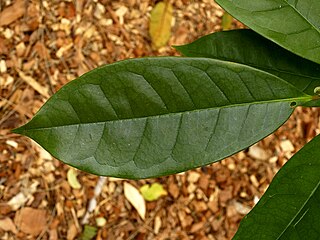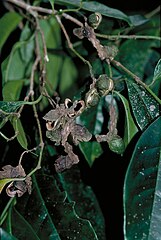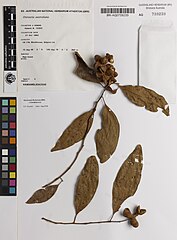
Helicia australasica, also known as Austral oak or creek silky oak, is a species of rainforest tree in the macadamia family Proteaceae, native to New Guinea and northern and northeastern Australia.

Euroschinus falcatus is a large tree in the mango and cashew family Anacardiaceae, found along almost the entire east coast of Australia from Cape York Peninsula to Jervis Bay. Common names include blush cudgerie and maiden's blush.

Fieldia australis, usually referred to as fieldia, is a small climbing plant or epiphyte found in the rainforests of eastern Australia, ranging from southeastern Queensland to Victoria. It is the sole species in genus Fieldia. Commonly seen in the cooler rainforests at higher elevations, it also grows in the warmer rainforests with a high humidity. The plant uses adventitious roots to grip hold of tree trunks, mossy rocks or tree ferns.
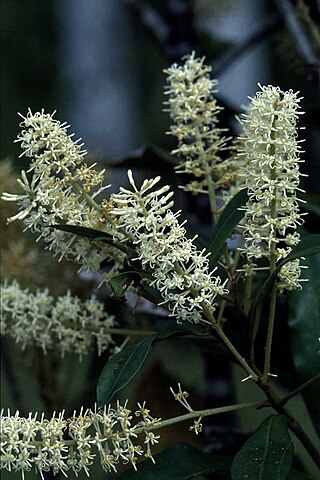
Nothorites is a monotypic genus in the macadamia family Proteaceae. The sole species, Nothorites megacarpus, is endemic to the wet tropics rain forests of northeastern Queensland, Australia.

Syzygium canicortex, commonly known as yellow satinash, is a tree in the family Myrtaceae native to Queensland, Australia, first described in 1983.

Bouchardatia neurococca, commonly known as union nut, is a species of small rainforest tree that is endemic to eastern Australia. It has pinnate leaves with three or five narrow elliptical leaflets, white flowers arranged in panicles, and oval follicles.
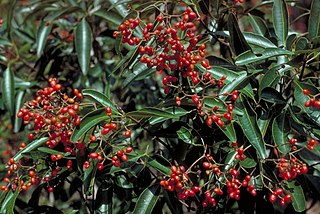
Dinosperma is a genus of plant containing the single species Dinosperma erythrococcum, commonly known as tingletongue, clubwood or nutmeg, and is endemic to north-eastern Australia. It is a tree usually with trifoliate leaves arranged in opposite pairs, the leaflets lance-shaped to oblong, and panicles of small white flowers, later bright orange to red, slightly fleshy follicles containing shiny, bluish black seeds.

Palaquium galactoxylum, commonly known as Cairns pencil cedar, Daintree maple or red silkwood, is a species of plants in the star apple family Sapotaceae which is endemic to rainforests of New Guinea and northern Australia. It can produce spectacularly large buttress roots.
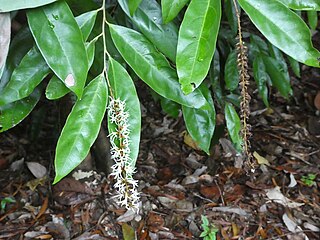
Neostrearia is a monotypic genus - i.e. a genus containing only one species - of plants in the witch-hazel family Hamamelidaceae. It is the second described of three monotypic Australian genera in this family, the others being Ostrearia and Noahdendron. It is most closely related to these genera, as well as Trichocladus from southern Africa and Dicoryphe from Madagascar, and together these five genera form a distinct clade within Hamamelidaceae.

Noadendron is a monotypic genus - i.e. a genus containing only one species - of plants in the witch-hazel family Hamamelidaceae. It is the third described of three monotypic Australian genera in this family, the others being Ostrearia and Neostrearia. It is most closely related to these genera, as well as Trichocladus from southern Africa and Dicoryphe from Madagascar, and together these five genera form a distinct clade within Hamamelidaceae.

Mackinlaya macrosciadea, commonly known as mackinlaya or blue umbrella, is a plant in the carrot, fennel and parsley family Apiaceae, found in the Northern Territory and Queensland, Australia.

Syzygium unipunctatum, commonly known as the rolypoly satinash, is a small tree in the family Myrtaceae. It is endemic to the rainforests of the Wet Tropics of Queensland.

Diploglottis harpullioides, commonly known as Babinda tamarind, is a rainforest tree in the lychee and maple family Sapindaceae which is found only in northeast Queensland, Australia.

Alpinia arctiflora, commonly known as the pleated ginger, is a plant in the ginger family Zingiberaceae which is endemic to northeastern Queensland.

Peripentadenia mearsii, commonly known as the buff quandong or grey quandong, is a plant in the family Elaeocarpaceae endemic to a small part of northeastern Queensland, Australia. It is usually seen as a multistemmed tree, and the habitat is tropical rainforest.

Debregeasia australis, commonly known as china grass or native ramie, is a plant in the nettle family Urticaceae endemic to Queensland, Australia.

Peperomia enervis is a plant in the pepper family Piperaceae found only in rainforests of northeast Queensland near the cities of Cairns and Mackay. It was first described in 1891.

Syzygium alatoramulum, commonly known as tinkling satinash, is a plant in the clove and eucalyptus family Myrtaceae, found only in the Wet Tropics bioregion of Queensland, Australia.

Syzygium graveolens, commonly known as cassowary satinash, is a plant in the eucalyptus family Myrtaceae found only in the Wet Tropics bioregion of Queensland, Australia.

Balanops australiana, commonly known as pimplebark, is a plant in the family Balanopaceae found only in the coastal regions of northern and central Queensland, Australia.

